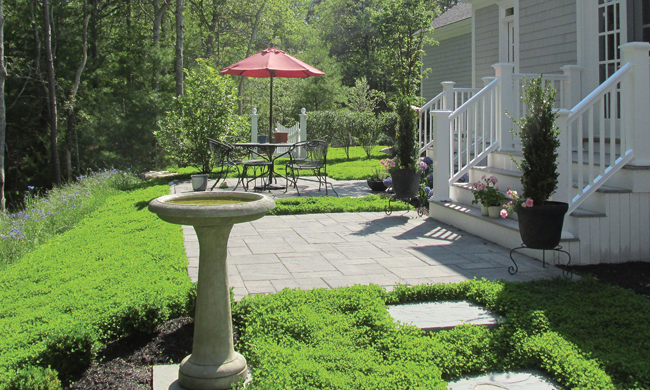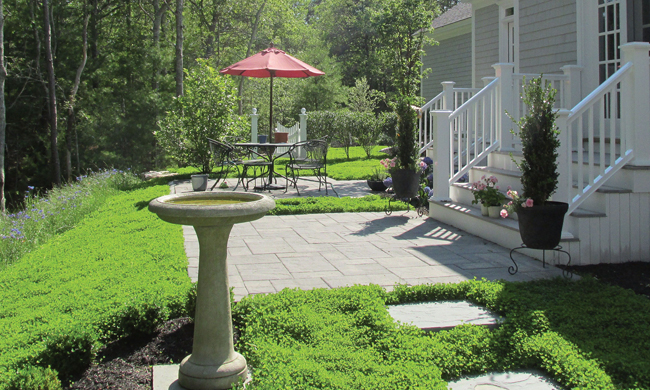Rethink Your Lawn


Use clover for a lush, green, eco-friendly, enviable yard
(Family Features) Who has time to continuously care for that carpet-like, green grass almost everyone longs for? Nearly no one. Cultivating a lush, green lawn takes time, can be expensive and is a mainstay on weekend to-do lists spring through fall. Now that’s a serious commitment.
Traditional turf lawns require a lot of maintenance. You must mow and remove weeds often, plus the amount of water usage can be staggering. The average American family uses 320 gallons of water per day, about 30% devoted to outdoor uses, according to the EPA. More than half of that is used for watering lawns and gardens. Nationwide, landscape irrigation is estimated to account for almost one-third of all residential water use, totaling nearly 9 billion gallons per day.
It’s about time to rethink the obsession with turf grass lawns and take a page from the past; clover can help create a great-looking lawn. Several decades ago, clover was considered so essential for lawns that it was a standard component in lawn seed mixes and wasn’t considered a weed. Clover was branded a weed when agricultural chemical companies created herbicides to rid lawns of broadleaf plants. The herbicides had no effect on grass, but killed everything else, clovers included, which is how clover became identified as a weed.
It’s not too late to renovate your lawn and reintroduce the springy, soft, green carpet of clover back into your lawn. It’s fluffy on the feet, aids in both weed and erosion control and, when used to overseed existing lawns, fills in bare spots fast.
Today, as interest grows in more natural, eco-friendly ways to care for grass, you might consider totally replacing your lawn with an option like Miniclover, which should not be confused with invasive white Dutch clover.
“Miniclover is about one-third to half the size of white Dutch clover, producing a thick, carpet-like appearance that blends well with turf,” said Troy Hake, president and owner of Outsidepride.com, which offers a multitude of seeds, including grasses, clovers, wildflowers, herbs and more. “It’s especially attractive, cost effective, eco-friendly and can help you get that thick, lush, green lawn your neighbors will envy.”
In addition to providing weed and erosion control, the fluffy lawn alternative offers a variety of benefits:
Nitrogen fixer. Miniclover takes nitrogen from the air and “fixes” it in your soil, eliminating the need to apply nitrogen plant food because it does the work for you, keeping lawns green and growing while adding natural nitrogen to the soil.
Drought tolerant. Miniclover has longer, deeper roots than turf grass, reaching down into the soil for the moisture they need, so you won’t need to water as much during normal weather conditions. Plus, it stays green year-round and is resistant to drought and tolerates wet conditions.
Controls weeds. Its dense structure and growth habits help suppress existing weeds and the establishment of new weeds, as it grows via stolons (stems that grow horizontally along the ground).
Low to no maintenance. You can mow Miniclover – the more it’s cut, the smaller the leaf size – or simply let it grow, as it only grows 4-6 inches tall and doesn’t get unwieldy, making it an ideal lawn alternative or healthy addition to your lawn.
Thrives in sun to partial shade. Unlike some turfgrass types, Miniclover does well in partial shade that receives at least some direct sunshine daily.
Stands up to foot traffic. It has superior wear tolerance over turf grass, does well in compacted soil and fills bare spots quickly.
Makes great groundcover. Grow it alone or, because of its adaptability and ability to grow in a wide variety of conditions, combine it with other groundcover plants, like creeping phlox, ivy and thyme.
It’s time to rethink typical lawn turf and try an eco-friendly alternative to replace or renovate your lawn. For more information, visit Outsidepride.com.
SOURCE:
Outsidepride.com







